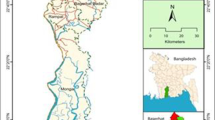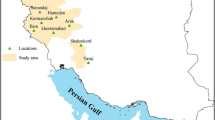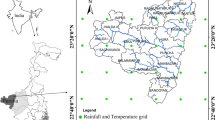Abstract
Crop yield in rainfed conditions is greatly influenced by meteorological parameters such as rainfall and evapotranspiration. As climate indices (AO, NAO, PNA, NINO-3.4, and AAO) are available for the future months, finding the relationship between crop yield with meteorological parameters and the relationship between meteorological parameters with climate indices can be very useful in predicting annual fluctuations in rainfed crop yield. In the current study, the association between rainfall, PET, and AI with barley and wheat rainfed detrended yields (1990–2016) and the relationship between AI and climate indices (AO, NAO, PNA, NINO-3.4, and AAO) were assessed for Chaharmahal and Bakhtiari province in the west of Iran. All associations were assessed at annual and seasonal (wet and dry seasons) scale considering both concurrent and lag correlations (1-year and 2-year lag). Our results showed a significant correlation between rainfall and AI with crop yields in all study locations except Kouhrang in both annual and wet season time scales. The results indicated that except Kouhrang, where the temperature is a limiting factor to crop yields, in all Chaharmahal and Bakhtiari areas, drought is one of the key factors of annual yield variability (significant correlation between AI and crop yields). The significant correlation between AI with NINO-3.4 and AAO also was observed in both annual and wet season time scales. It seems that NINO-3.4 and AAO indices can be useful to estimate grain yield of rainfed barley and wheat, predict drought occurrence, and take possible actions to counter such conditions.







Similar content being viewed by others

Abbreviations
- AI:
-
Aridity index
- PET:
-
Potential evapotranspiration
- AO:
-
Arctic oscillation
- NAO:
-
North Atlantic Oscillation
- PNA:
-
Pacific/North American pattern
- AAO:
-
Antarctic Oscillation
- PDSI:
-
Palmer Drought Severity Index
- RAI:
-
Rainfall Anomaly Index
- CMI:
-
Crop Moisture Index
- BMDI:
-
Bhalme and Mooley Drought Index
- SWSI:
-
Surface Water Supply Index
- RI:
-
National Rainfall Index
- SPI:
-
Standardized Precipitation Index
- RDI:
-
Reclamation Drought Index
References
ABM (Australian Bureau of Meteorology). (2013). The Southern annular mode of accessed. http://www.bom.gov.au/climate/sam/
Anonymous. (2019). Agricultural Statistics (97 pp.). Publications of the Ministry of Jihad for Agriculture of Iran.
Bannayan, M., & Hoogenboom, G. (2008). Weather analogue: A tool for real-time prediction of daily weather data realizations based on a modified k-nearest neighbor approach. Environmental Modelling and Software, 23, 703–713.
Bannayan, M., Sanjani, S., Alizadeh, A., Lotfabadi, S. S., & Mohamadian, A. (2010). Association between climate indices, aridity index, and rainfed crop yield in northeast of Iran. Field Crops Research, 118, 105–114.
Barlow, M., Cullen, H., & Lyon, B. (2002). Drought in central and southwest Asia: La Niña, the warm pool, and Indian Ocean precipitation. Journal of Climate, 15, 697–700.
Dai, A., & Wigley, T. M. L. (2000). Global patterns of ENSO-induced precipitation. Geophysical Research Letters, 27, 1283–1286.
de Martonne, E. (1926). Une nouvelle function climatologique: L’indice d’aridité. Meteorologie, 2, 449–459.
Diaz, H. F. (2000). El Niño and the Southern Oscillation: Multiscale variability and global and regional impacts. Cambridge University Press.
Díaz-Solís, H., Grant, W. E., Kothmann, M. M., Teague, W. R., & Díaz-García, J. A. (2009). Adaptive management of stocking rates to reduce effects of drought on cow-calf production systems in semi-arid rangelands. Agricultural Systems, 100, 43–50.
Frieler, K., Schauberger, B., Arneth, A., Balkovič, J., Chryssanthacopoulos, J., Deryng, D., Elliott, J., Folberth, C., Khabarov, N., & Müller, C. (2017). Understanding the weather signal in national crop-yield variability. Earth’s Future, 5, 605–616.
Ghasemi, A. R., & Khalili, D. (2006). The influence of the Arctic Oscillation on winter temperatures in Iran. Theoretical and Applied Climatology, 85, 149–164.
Gong, D., & Wang, S. (1999). Definition of Antarctic oscillation index. Geophysical Research Letters, 26, 459–462.
Guarín, A., & Taylor, A. H. (2005). Drought triggered tree mortality in mixed conifer forests in Yosemite National Park, California, USA. Forest Ecology and Management, 218, 229–244.
Hurrell, J. W. (1995). Decadal trends in the North Atlantic Oscillation: regional temperatures and precipitation. Science, 269, 676–679.
Jensen, M.E., Burman, R.D., Allen, R.G. (1990). Evapotranspiration and irrigation water requirements. ASCE.
Kafle, H. K., & Bruins, H. J. (2009). Climatic trends in Israel 1970–2002: Warmer and increasing aridity inland. Climate Change, 96, 63–77.
Karimzadeh Soureshjani, H., Ghorbani Dehkordi, A., & Bahador, M. (2019a). Temperature effect on yield of winter and spring irrigated crops. Agricultural and Forest Meteorology, 279, 7664.
Karimzadeh Soureshjani, H., Nezami, A., Kafi, M., & Tadayon, M. (2019b). Responses of two common bean (Phaseolus vulgaris L.) genotypes to deficit irrigation. Agricultural Water Management, 213, 270–279.
Karimzadeh Soureshjani, H., Nezami, A., Kafi, M., & Tadayon, M. (2020). The Effect of Deficit Irrigation on Dry Matter Partitioning, Mobilization and Radiation Use Efficiency of Common Bean (Phaseolus Vulgaris L.). Communications in Soil Science and Plant Analysis, 51, 307–326.
Kiladis, G. N., & Diaz, H. F. (1989). Global climatic anomalies associated with extremes in the Southern Oscillation. Journal of Climate, 2, 1069–1090.
LaViola, J.J. (2003). An experiment comparing double exponential smoothing and Kalman filter-based predictive tracking algorithms. In IEEE Virtual Reality, 2003. Proceedings (pp. 283–284). IEEE.
Liu, X., Zhang, D., Luo, Y., & Liu, C. (2013). Spatial and temporal changes in aridity index in northwest China: 1960 to 2010. Theoretical and Applied Climatology, 112, 307–316.
Lobell, D. B., & Field, C. B. (2007). Global scale climate–crop yield relationships and the impacts of recent warming. Environmental Research Letters, 2, 14002.
McKee, T. B., Doesken, N. J., Kleist, J. (1993). The relationship of drought frequency and duration to time scales. Proceedings of the 8th Conference on Applied Climatology, 17(29), 179–183.
McKee, T. B. (1995). Drought monitoring with multiple time scales. In Proceedings of 9th Conference on Applied Climatology. Boston.
Narasimhan, B., & Srinivasan, R. (2005). Development and evaluation of Soil Moisture Deficit Index (SMDI) and Evapotranspiration Deficit Index (ETDI) for agricultural drought monitoring. Agricultural and Forest Meteorology, 133, 69–88.
Nazemosadat, M. J. (2001). Winter drought in Iran: Associations with ENSO. Drought Network News, 13, 1.
Nazemosadat, M. J., & Cordery, I. (2000). On the relationships between ENSO and autumn rainfall in Iran. International Journal of Climatology: A Journal of the Royal Meteorological Society, 20, 47–61.
NOAA. (2020). National Oceanic and Atmospheric Administration [WWW Document]. https://www.cpc.ncep.noaa.gov/products/precip/CWlink/daily_ao_index/teleconnections.shtml.
Oba, G. (2001). The effect of multiple droughts on cattle in Obbu, Northern Kenya. Journal of Arid Environment, 49, 375–386.
Ogi, M., Tachibana, Y., Yamazaki, K. (2003). Impact of the wintertime North Atlantic Oscillation (NAO) on the summertime atmospheric circulation. Geophysical Research Letter, 30.
Rao, V. B., Sá, L. D. A., Franchito, S. H., & Hada, K. (1997). Interannual variations of rainfall and corn yields in Northeast Brazil. Agricultural and Forest Meteorology, 85, 63–74.
Romero, C. C., Baigorria, G. A., & Stroosnijder, L. (2007). Changes of erosive rainfall for El Niño and La Niña years in the northern Andean highlands of Peru. Climate Change, 85, 343–356.
Ropelewski, C. F., & Halpert, M. S. (1986). North American precipitation and temperature patterns associated with the El Niño/Southern Oscillation (ENSO). Monthly Weather Review, 114, 2352–2362.
Sun, L., Li, H., Ward, M. N., & Moncunill, D. F. (2007). Climate variability and corn yields in semiarid Ceará, Brazil. Journal of Applied Meteorology and Climatology, 46, 226–240.
Thompson, D. W. J., Solomon, S., Kushner, P. J., England, M. H., Grise, K. M., & Karoly, D. J. (2011). Signatures of the Antarctic ozone hole in Southern Hemisphere surface climate change. Nature Geoscience, 4, 741–749.
Thompson, D. W. J., & Wallace, J. M. (1998). The Arctic Oscillation signature in the wintertime geopotential height and temperature fields. Geophysical Research Letters, 25, 1297–1300.
Trenberth, K. E. (1997). The definition of el nino. Bulletin of the American Meteorological Society, 78, 2771–2778.
UNEP. (1992). United Nations Environment Programme (UNEP). World Atlas Desertif.
Weghorst, K. M. (1996). The reclamation drought index: Guidelines and practical applications. Bur Reclamation.
Wu, S., Bates, B., Zbigniew Kundzewicz, A. W., & Palutikof, J. (2008). Climate change and water. Tech. Pap. Intergov. Panel Clim. Chang.
Zhao, C., Liu, B., Piao, S., Wang, X., Lobell, D. B., Huang, Y., Huang, M., Yao, Y., Bassu, S., & Ciais, P. (2017). Temperature increase reduces global yields of major crops in four independent estimates. Proceedings of the National Academy of Sciences, 114, 9326–9331.
Author information
Authors and Affiliations
Corresponding author
Ethics declarations
Conflict of interest
The author declares that there is no conflict of interest.
Rights and permissions
About this article
Cite this article
Karimzadeh Soureshjani, H. Relationship Between Weather Conditions and Climate Indices with Rainfed Crop Yield. Int. J. Plant Prod. 15, 541–551 (2021). https://doi.org/10.1007/s42106-021-00160-6
Received:
Accepted:
Published:
Issue Date:
DOI: https://doi.org/10.1007/s42106-021-00160-6



